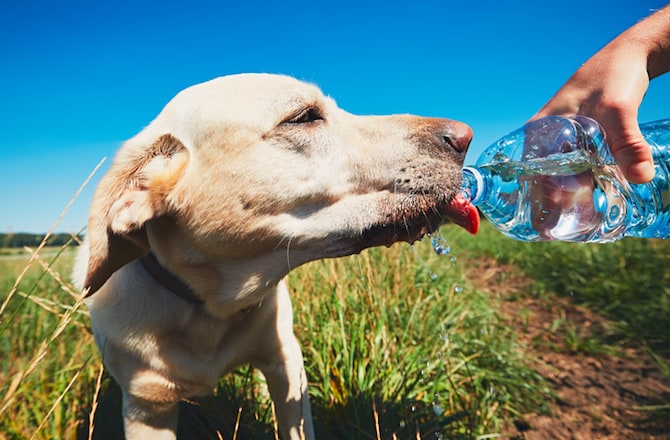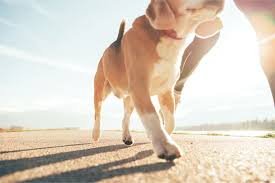When Is It Too Hot to Walk Your Dog?
Before you walk your dog in the lovely sunny weather, you need to ensure that it is not too hot to walk your dog outside. Does this mean that you should never walk your dog in summer? No. The animal welfare charity RSPCA acknowledged that even in hot weather, dogs need exercise.
However, as a pet owner, you are advised to walk your dog during the cooler moments of the day. This could be early mornings or late evenings. Walking your dog in high temperatures puts the dog at risk of developing heatstroke or suffering from burnt paws.
RSPCA recommends the five-second test to dog owners. This is whereby you place your hand on the pavement for about five seconds. If the pavement is too hot for the palm of your hand, it is probably too hot for the paws of the dog too.
Some heatstroke cases in dogs end in tragedy, so ensure that you always check the weather before walking your dog. Otherwise, you could end up walking your dog to its doom. We have prepared a guide below that will let you know the right time to walk your dog.
For more information on how to care for your dog, the benefits of daily walks and other canine insights, check out Boni Dogs.
Temperatures to look out for
It is safe to walk your dog in temperatures not more than 19 degrees Celsius, especially if the dog is well hydrated. So, always ensure that you give your dog enough water to drink before you take it for a stroll.
Any temperature above 20 degrees Celsius puts your dog at risk of developing a heat stroke. In such high temperatures, 15 minutes of exposure is enough to affect your beloved pet fatally.
Temperatures between 16 and 19 degrees Celsius are considered generally safe for dogs. However, temperatures between 20 and 23 degrees Celsius could drop your dog’s survival rate to 4 out of 10.
Temperatures around 24 to 27 degrees Celsius give your dog a 1 out of 10 survival rate while temperatures above 32 degrees Celsius, leaving your dog with zero survival rate. At this point, taking your dog for a walk is basically animal cruelty.
Dogs are more prone to heatstroke when compared to human beings because unlike us, dogs cannot sweat through their skin. All the heat from the sun builds up within them.
Dogs rely on panting to release the heat through their nose and mouth. The paw pads of dogs also work to release some heat and regulate the body temperature to keep the dog cool.
So, imagine how difficult it is for the dog when the exit parts of its body heat (paw pads) are exposed to the scorching hot pathways, in temperatures above 20 degrees.
Do you like to take your dog with you in the car when running regular errands? We highly advise against leaving your dog. If the temperatures outside are 22 degrees Celsius, the temperature inside the car could go as high as 47 degrees Celsius in an hour.
If your dog appears distressed while in the car, open the doors immediately and get emergency help for it.
Signs your dog has burnt paws
If you notice the following signs when walking your dog, it could be a sign that its paws are burnt.
- The paw of the dog has redness and blisters
- The pad has a missing part
- The pads of the dog seem darker in colour
- The dog appears to be limping, and in some cases, it may refuse to walk
- Your dog keeps licking or chewing at its paw
Signs of a heat stroke
What happens if you walk your dog and it starts developing heat stroke? Below are some of the heatstroke signs in a dog to watch out for. They include:
- The dog starts panting heavily
- You can notice excessive drool coming out of the dog’s mouth
- In some cases, the dog may vomit due to the heat
- The dog appears lethargic and drowsy
- You notice that the dog is uncoordinated e.g. may sway as it walks
- In severe cases, the dog might start vomiting
What to do after a heat stroke
If you realize that your dog is suffering from heatstroke, we recommend that you take the following steps:
Step 1
Move the dog to a cool place immediately. This could be indoors or under a shade. The quicker you get the dog away from the scorching sun, the better.
Step 2
Give the dog some cool water to drink and pour some of it on its coat so that it can cool down. Do not use freezing water because it will result in the dog’s start shivering, thereby doing more harm than good.
Step 3
Keep pouring cool water over your dog until you the panting has slowed down and the dog is breathing normally.
Step 4
Once the dog cools down, take it to the nearest vet immediately. Urgent action is required because you never know the damage the heatstroke may have had on the dog.
Your pet’s safety should be your priority at all times. This means that you should always double-check the prevailing outdoor temperatures before walking your dog outside.



